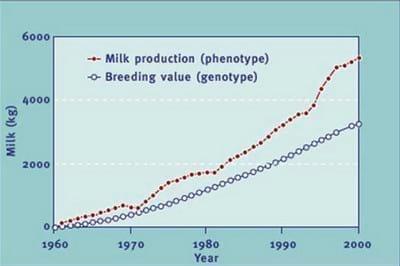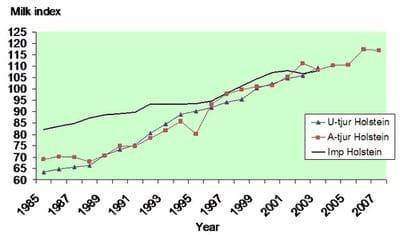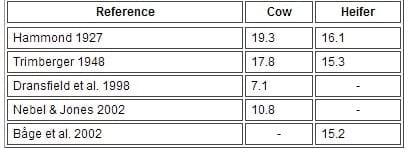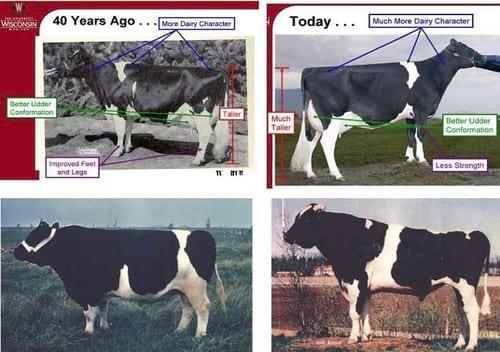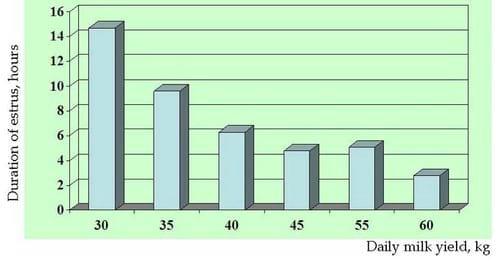INTRODUCTION
Milk yield of the dairy cows has increased rapidly over the past 40 yeras and, in some European countries more than doubled, due to a combitation of improved genetics, feeding and management, with an overwhelming focus on milk production volumes. Fig. 1 depicts recent (years 2003 to 2008) global trends in yearly milk yield/cow in selected countries/regions. Sweden is leading the European Union (EU) milk yield league with national averages of 9,718 kg of Energy Corrected Milk (ECM) lactation for Swedish Holsteins (SH) and 9,164 kg for Swedish Red cows (SR) (2006/2007) (Swedish Dairy Association 2008) (see Fig. 2).
Figure 1. Global trends in milk yield per cow-year (kg) in selected countries/regions for the period 2003–2008
Figure 2. Average annual milk production (kg energy-corrected milk, ECM) for cows of the Swedish Red (SR) and Swedish Holstein (SH) breeds, period 1955–2005
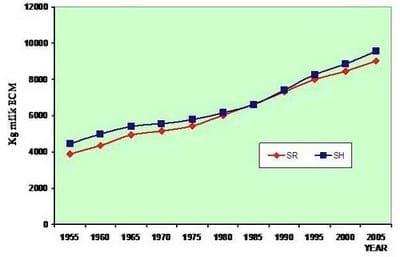
Overall, the genetic gain in milk production reaches 1.5% per year, mostly owing to the effective use of artificial insemination (AI), progeny testing, and intense selection of bulls for world-wide use. However, this high milk productivity has been shadowed by a documented global decrease in average dairy herd reproductive performance (e.g., the ability of the female to produce a live calf), particularly for the dominating Holstein breed (see trends for selected countries in Fig. 3). Fertility, a component of reproductive performance defines the ability of the female to become pregnant, but it is -at the end- reflected in the birth of a calf. Fertility is usually monitored by indirect (and sometimes erratic) rates of non-return to estrus (NRRs) or by the more accurate conception (CRs) or pregnancy rates (PRs), resulting from clinical examinations. Interestingly, while fertilization rates in dairy cattle can be as high as 85 - 90%, and CRs are probably above 70%, calving rates in Holsteins are below 40% in most cases and in some reports as low as 25%, decreasing at rates of 0.5 - 1.0 % units/year in American Holstein, a problem that was detected already in the late 1950´s.
Figure 3. Trends of fertility decrease in Holstein cattle in selected countries between 1988 and 2006. Note the more horizontal slope for the Swedish population, compared to the other countries
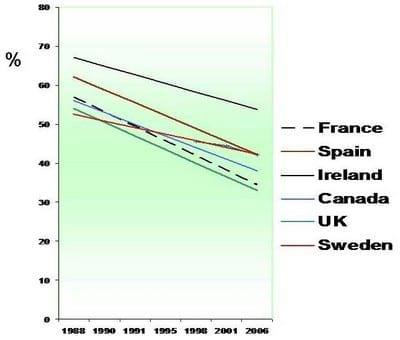
Such a decline in calving rates is, however, not observed in Holstein heifers. Reproductive performance, being affected by fertility, embryonic and fetal development, and ultimately by calf survival; is monitored by indicators such as the interval between calving and successful breeding (number of days open, DO) or the interval between successive calvings (CI). Both these indicators are affected by bull and cow fertility and by herd management factors, such as estrous detection, number of AIs per conception, and the interval between calving and time to the first AI. Fig. 4 A-B clearly illustrates trends of increased numbers of DO, of services per conception and of extended CIs in American Holstein cows, over the past 25 to 35 years, respectively. These are indicators of a decreasing reproductive performance which, increasing culling, adds significant costs to an already constrained milk production sector.
Figure 4. (A) Average calving interval (CI, months) in American Holstein cows for the period 1970–2005
Figure 4. (B) Changes in days open (DO) and services per conception in 73 Holstein herds in Kentucky, USA 1972–1996
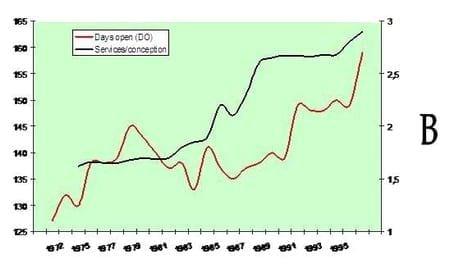
Fertility is one of the most complex measures of reproduction, being undisputedly influenced by genes and environment. However, although these two components act in concert, they synergistically mask the contribution of the other thus confounding selection strategies for fertility and, ultimately, affecting reproductive performance. As already mentioned, milk yield-focused selection has been tradition in dairy. Unfortunately, there are clear negative genetic relationships (several times stronger than the phenotypic ones) between milk yield with fertility, presence of mastitis and other health traits. Surprisingly, large genetic variation is found in these fitness- and welfare-related traits, despite their low heritability. The unfavourable correlations found were mostly ~0.2 - 0.4, indicating that selection for milk yield alone would lead to poorer fertility and animal health, thus seriously affecting cow welfare. However, as the correlations are far from unity, they also indicate that there are individual cows which can combine a high yield with good health and fertility, as has been seen in Sweden, provided the cow has inherited good genes for both milk production and fertility and/or that management is of such quality that it can compensate for the negative genetic effect.
Unfortunately, such compensatory management is hard to apply in large herds (a product of the structural change suffered by the dairy production sector), where high-producing cows, e.g., with >11,000 yearly kg milk yield are most often seen, unless proper buildings, enough well-trained personnel with time to work with the animals are present. The increasing use of do-it-yourself-AI (DIY-AI) has been associated to increasing costs. In Sweden, where ~40% of the AIs are performed by the farmers themselves (the highest figure in Scandinavia), the DIY-AI fertility is ~3 - 4% lower than that reached by AI-technicians (Swedish Dairy Association 2008). Less time available for estrous detection is among the reasons, but also weaker display of estrous signs has been recorded.
In any case, at a global scale, most modern dairy AI-bulls have been primarily selected for the single trait of milk yield, with dramatic increases in genetic gain but accompanied with a decline in reproductive performance, probably by the insufficient correlation between these two traits. Most dairy cows, particularly those high-yielding, suffer of a negative energy balance (NEB) period during the first weeks of lactation, when energy output in milk exceeds energy intake from the diet. Such NEB is associated with a multi-factorial syndrome of sub-fertility during this period, when ovarian function (monitored as estrus and ovulation) is to be re-established to warrant a new pregnancy, the prerequisite for a renewed lactation. Moreover, the increasing use of unbalanced breeding in particularly the Holstein breed has caused declining calving rates over the past decades in countries that had heavily used this breed. A series of questions are therefore presented, involving genetic selection, nutrition and management, for instance: Has the potential of cows to consume man-prepared feedstuffs for ruminants (concentrates, etc), often combined with some feeding strategies (such as the use of Total Mixed Ration, TMR) increased in pace with their production? Do all high-yielding cows suffer from serious metabolic stress (MS) and NEB, serious enough to dramatically impair their fertility? Has the use of exogenous hormones caused inhibition of estrus signaling? Is a constrained estrus signaling the major problem? When do reproductive losses occur? To what extent does the male, through epigenetic mechanisms, contribute to these losses? Should milk production be lowered in order to increase fertility? Evidently, considering the latter, there is also a need for well-designed bioethical studies to enable a constructive societal debate regarding sustainable milk production. Additionally, we need to determine the biological mechanisms behind the relationships between productivity, animal health and welfare. Most importantly, we need to know how we can best measure and correct the current misfit, at the lowest possible cost, to the highest possible accuracy and in a long-lasting perspective. Obviously, understanding the reasons behind and devising proper solutions for such multifactorial problems require integration of many disciplines, including genetics, housing, management, nutrition, immunology, molecular biology, endocrinology, metabolic and reproductive physiology, ethology, and animal welfare.
The present paper reviews the state-of-the-art of the multifaceted problem of infertility and decreased reproductive performance in high-producing dairy cattle and suggest short-, medium- and long-term solutions available to ameliorate it or aid to its permanent solution.
Is Selection for High Yield the Major Cause of this Problem?
Since genetic merit for milk production is generally recognized as the single most important objective in breeding programs for dairy cattle (mostly considering the low heritability of most common fertility traits, usually below 5%, owing to environment pressure), focus in breeding dairy has been primarily put, worldwide, on milk yield (but, in some countries, also on milk quality). As a result, in breeds such as the American Holstein, the genetic potential for milk production has increased by over 3,000 kg per lactation, and doubled over a 40-year period (Fig. 5). A broader illustration of how successful a focused genetic selection of AI-bulls for higher milk production can be is given in Fig. 6, which depicts the milk index for Holstein bulls ranked by Interbull (International Bull Evaluation Service) in a series of countries. Since the efficient transmission of this production trait to the progeny requires a high rate of reproduction, preferably via AI; low-fertility cows or AI with semen from low-fertile bulls will eventually result in poor CRs and hence limit the genetic and economic progress. In other words, fertility is most relevant to the dairy industry.
Figure 5. Trends of the genetic merit (breeding value) of AI bulls and actual average milk production of Holstein cows in the United States
Figure 6. Genetic trend (milk index) for Holstein bulls in various countries ranked by Interbull August 2006, Nordic base and scale
Healthy, progeny-tested elite bulls are capable of producing well over 100,000 straws/year of frozen semen. Thus, there is need for only a relatively small number (<1,000 if all cows in the world were to be covered within one year!) of proven bull sires to service the world's population of dairy cows. A steady increase of exports of the North American Holstein from the 1970’s into the 1990’s (because of its perceived superiority regarding milk yield and other dairy traits compared with European lines) has led to a globalization of dairy genetics with bulls that are closely related, resulting in increasing inbreeding levels.
Most geneticists agree that inappropriate use of sires, selected without taking enough consideration to reproductive traits and focusing mainly for increased milk production, in countries that heavily used American Holsteins, has led a documented decline in reproduction success. In some examples, the impairment of fertility and health has reached such an extent that it is now being considered a major obstacle for milk production management. In the UK, for instance, pregnancy rate to first service has dropped from 56% in 1972 - 1982 to about 40% in 1995 - 1998, a rate of about 1% per year (see Fig. 3). This phenotypic trend is probably mainly caused by genetic deterioration in this breed since the problem is still there, despite having included reproductive performance both in the breeding goal and as selection criterion. Using mathematical mechanistic modeling, UK researchers have prognosed that the current trend would lead the national dairy herd to be unsustainable due to increasing calving intervals and reduced fertility in as few as 10 years. A yet undisclosed chapter is the possible presence of aberrant paternal mRNA in the spermatozoa which might cause epigenetic-like defects, visible during either early embryonic development, placental development or later fetal development, as we shall discuss later.
Actions have been taken to counteract these undesirable effects. The industry has used genetic markers to track recessive genetic disorders (qualitative traits) but the impact of tracking quantitative traits is yet limited. Interbull has, over the last decade, launched international genetic evaluations for female fertility, mastitis and longevity, aiming at a fair comparison of bulls for non-production traits, both for Holstein and other main breeds of the Interbull member countries. However, comparisons are not yet global, and there are still many other bulls marketed, which are yet to be included in the breeding selection schemes promoted by Interbull. Fortunately, the emphasis of selection continues anyway to change from production to non-production traits, especially towards health and robustness, in an increasing number of countries, albeit with a large variation in their relative weight as selection indices (Fig. 7). However, because this breeding selection is relatively slow, other measures have been taken to ameliorate poor fertility, the major breeding and management issue faced today by dairy farmers. For instance, crossbreeding has become mode, capitalizing on heterosis and the incorporation of breeds where selection has already gained from an important consideration for fertility (and other health traits) in the breeding goal.
Figure 7. Relative proportions (%) of components of breeding selection indices for production (gray), longevity (white), and health and reproduction (black) in selected countries, August 2003
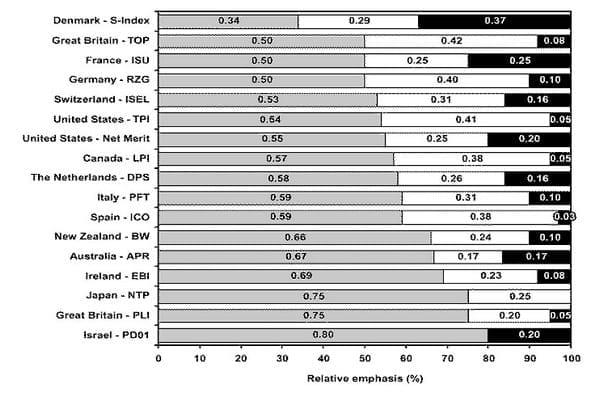
Probably, the most important and long-lasting action has been demonstrated by the Scandinavian/Nordic breeders. They have obviously selected for increased milk yield. Fig. 8 depicts such increasing trend for Holstein Swedish (SH) bulls (both for unproven bulls, proven bulls and imported semen of different sources), which has been accompanied by a decrease in daughter fertility (Fig. 9), confirming that genetically-driven milk production in dairy cows is clearly negatively associated with fertility and with increased prevalence of mastitis. There are, however, clear breed differences. The bull breeding values for daughter fertility within the SH breed dropped with more than two standard deviations over the past 20 years (Fig. 10). Twenty years ago, 50% of SH bulls had a breeding value equal to the mean or better. Today, less than 2% of the bulls reach the same quality. Moreover, while the SH has shown a decrease in fertility or reproductive performance at a rate of ~1.2 index units/year (~0.25% units/year) until 2007, the Swedish Red breed (SR) has maintained fertility over the same period, despite also having a high milk production potential and similar milk yield (see Fig. 2 for average annual milk production for SR and SH breeds since 1955, and Fig. 10 for the trends in conception rates for the two breeds since 1998).
Figure 8. Milk index for AI Holstein sires in Sweden, as young (U), progeny-tested (A) or imported (Imp) for the period 1985-2007
Figure 9. Daughter fertility index for AI Holstein sires in Sweden, as young (U), progeny-tested (A) or imported (Imp) for the period 1985-2007

Figure 10. Conception rates (CR, including trend lines) per AI in dairy cattle of the Swedish Red (SR) and Swedish Holstein (SH) breeds, period 1998–2006, where fertility and health traits are included in the breeding goal
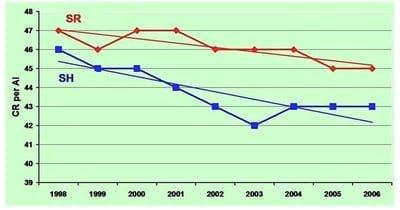
Overall, in comparison with other countries/regions, Sweden has been able to prevent the decline of daughter fertility (see Fig. 3) and to stabilize the resistance to mastitis by using a sound Swedish national breeding program and the direct incorporation of several reproduction and health functional traits (such as fertility, longevity, calving ease, udder health and claw health) for more than 30 years. The rationale behind has been that despite the low heritability of fertility and health traits, there is yet a significant genetic variation and thus a chance to balance the genetic gain for production and animal health and reproduction. Data in Sweden are available for all AI sires and for ~86% of the females in milk recording, thus making the system an outstanding tool for research, particularly for their linkage to underlying animal welfare mechanisms, upon which selection ought to be based. In sum, despite the obvious presence of complex physiological associations that most likely rule a negative genetic correlation between milk yield and fertility, such reduced fertility would not need to be a direct consequence of the genetically-driven increase in milk yield but rather a lack of proper selection weight for fertility traits in the breeding goal.
Management and nutrition also play important roles, considering the association between milk production and fertility varies between herds, both genotypically and phenotypically. Selection for increased milk-yield decreases the amount of total energy consumed that is used for maintenance, because such energy is -instead- used for the formation of milk, causing a genetically-induced NEB and a poorer body condition (BC), both physiological states directly linked to a decreased fertility. The so-called "expendable" processes (e.g., fat storage and reproduction) are the first to be down-regulated during nutrient deficiency or imbalance, while lactation, thermoregulation, growth and other "reducible" processes are maintained unless the nutritional status worsen. An aggravating detail is that although selection for milk yield partly increases feed intake (genetic correlation 0.45 - 0.65), it does not improve feed efficiency. Instead, it increases live weight (LW) and the proportion of metabolically active organs such as the gut or the liver due to a positive phenotypic correlation, ultimately leading to a dramatic increase in maintenance requirements. Maintenance requirements of a high producing Holstein dairy cow in the 21st century is >25% higher than 30 years ago following the changes in conformation (to a more angular cow) and size of the animals within the breed (see Fig. 11). Taken together, selection for milk yield has increased the gap between energy input and output during early lactation, leading to a deepened NEB and MS. The dilemma of genetically-driven milk yield improvement and MS raises important challenges for sustainability of the dairy industry. It clearly influences the ability of the cow to promptly resume ovulation postpartum, the success of fertilization and the ability of the conceptus to proceed with pregnancy (see below). However, the large individual differences observed in the magnitude of NEB, even among cows with similar milk yields, indicate that opportunity exists to meet this challenge, provided we can understand better the consequences of selection for increased milk yield on feed intake, NEB and on major welfare indicators, such as animal behaviour, health and fertility. Once again, Scandinavian data are clear on this point; increasing the weight for fertility traits in selection has halted the negative genetic decline while maintaining a large proportion of the yearly increase in milk yield, as shown in Fig. 2, Fig. 3 and Fig. 6. However, there is still much to be done in relation to, for instance, estrus signaling. The duration of estrus has -globally- become shorter over time (Table 1), presumably in direct relation to an increasing milk yield (see Fig. 12).
Table 1. Changes in the mean duration of estrus (h) in dairy cows and heifers - published data.
Figure 11. Changes in body conformation in American Holstein cows (upper) and bulls (below) during the past 40 years
Figure 12. Duration of standing estrus (h) in American Holstein cows with different milk yield





